As a business owner, you need to ensure your confidential information is safe and secure. If you have a shared ClickFunnels account, you may want to restrict access to it so that employees only have the permissions they need to do their job.
To restrict access to ClickFunnels, you should go to the “Accounts Settings” tab and click on the “Sub-users” option. You can add new users and select the desired permission settings. In addition, you can also restrict or allow access to specific features of your ClickFunnels account.
That’s just the tip of the iceberg. This post will discuss different ClickFunnels permissions, how to add a sub-user in ClickFunnels, and why you may want to restrict access to certain features. Let’s dive in.
How to Restrict ClickFunnels Permissions?
It’s good to understand how each level of permission works before deciding which ones to give your team members.
That way, you can be confident they have the permissions they need – no more, no less. To restrict a user’s access to ClickFunnels, follow these steps:
1. First, go to the account icon on the top right of the dashboard.
2. Hover the mouse over it and select “Account Settings” from the drop-down menu.
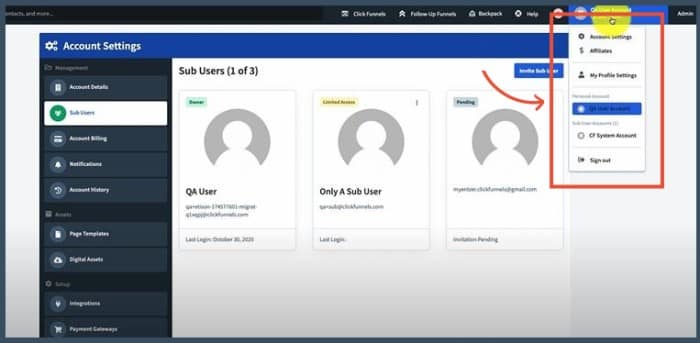
3. Click on the “Sub-users” tab from the list of options on the left side of the page.
4. You should see a list of all the current users with their respective permissions. If you need to, you can edit these permissions by clicking on the three dots on the right of the user profile.
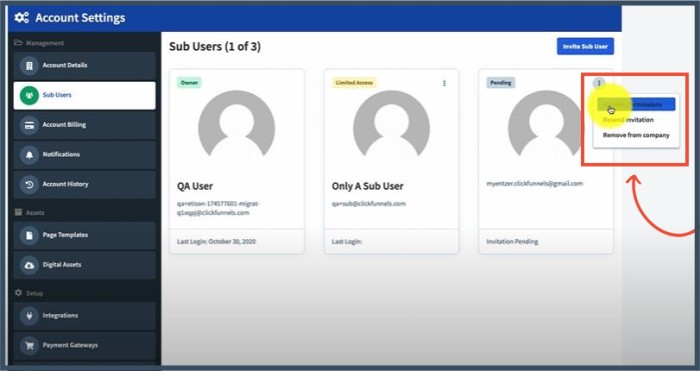
5. From the options, select “Manage Permissions.” The default option is to give full access to all the users. If you want to restrict some users, deselect this option.
6. You’ll see a list of all the features with specific permissions that you can select or deselect for each user.
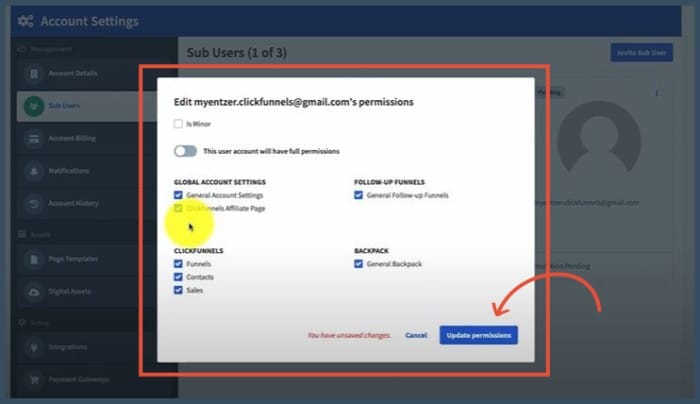
7. After selecting the desired permissions, click on the “Update Permissions” button at the bottom of the page. You’ve now successfully restricted access to ClickFunnels!
What Is a Sub-user in ClickFunnels?
A sub-user is a team member that has limited access to your ClickFunnels account.
For the Basic Plan, you can only have up to one sub-user. For the Platinum Package, you can have up to three sub-users.
Sub-users don’t necessarily need their own ClickFunnels account to access your account.
You can generate a link by inviting them through email, and they’ll be able to log in without creating an account.
Each user can have different levels of access, depending on what you want them to do.
Types of ClickFunnels Permissions
First, it is essential to note that only the account owner has access to the billing details.
They are also the only people who have the power to upgrade or change the subscription plan.
The account owner also has the power to delete users, add new ones, and change their permissions.
Now that we got that out of the way, let’s look at the different types of permissions in ClickFunnels.
1. Global Account Settings
Under this option, there are two types of permissions.
- General Settings: These permissions are the same for all team members and include options such as changing the account name, email address, and password. Users with these rights can change domains, SMTPs, integrations, and other options on the accounts setting page.
- ClickFunnels Affiliate Page: This allows users to access the ClickFunnels affiliate links and statistics. From this page, they can promote ClickFunnels products and receive a commission for every new member that joins through their link.
2. ClickFunnels
As the name suggests, this permission gives users access to ClickFunnels. They can use all the features and integrations in their account. Under this option, you can control these features.
- Funnels: The primary purpose of ClickFunnels is to build funnels. Selecting this option allows the user access to all funnel features. They will have the power to create, edit, and delete them.
- Contacts: As a business, one of your most valuable assets is your contact list. This permission allows users to view, add, and edit contacts in their accounts.
- Sales: If you have an eCommerce business, this permission comes in handy. It allows you to set which users can view orders, customers, and products.
3. Follow-up Funnels
With this permission, your team can use the email marketing features in ClickFunnels. They can create and send emails, as well as automate email sequences.
Follow-up Funnel (formerly Actionetics) is the ClickFunnels built-in CRM and email marketing tool.
You can give your team members access to this tool to manage your email list, contacts, and customers.
4. Backpack
The Backpack is an affiliate management system that allows you to run and grow your affiliate program.
This permission gives users the ability to create and manage their affiliate program from within their ClickFunnels account.
If you want to give someone access to only one feature, you can do that. For example, you can give someone access to funnels but not contacts.
The same goes for any other combination of features.
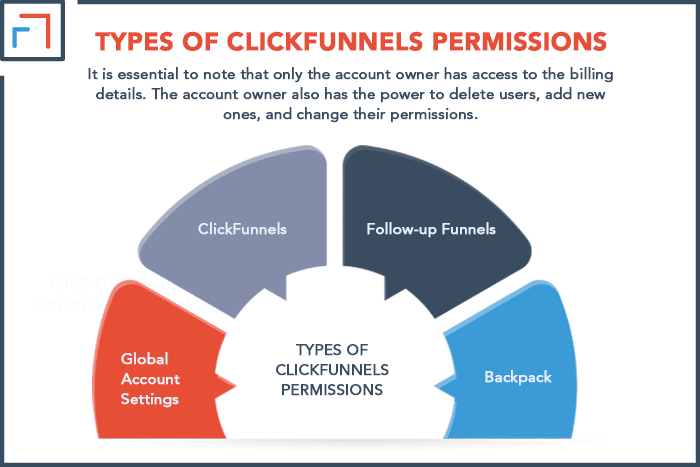
Who Needs Which Permission?
Now that you know the different types of permissions, you may be wondering who needs full and partial access.
The answer to this question depends on each person’s role in your organization.
For example, if you have someone who manages your funnels, they definitely need access to the “Funnels” permission.
On the other hand, if you have a contractor managing your email list, they will need access to the “Follow-up Funnel.”
As the account owner, you have control over all the features and can give or revoke access to anyone on your team.
1. Business Partners
It goes without saying that your business partners need access to ClickFunnels. After all, they are an essential part of your business.
Ideally, you want transparency with your partners to avoid any misunderstanding. Giving them full access is the best way to achieve that.
It’s also worth mentioning that you can give your partners access to only certain features.
2. Full-time Management Employees
As a business owner, you may have full-time employees who manage different aspects of your business.
In that case, you can give them access to ClickFunnels to do their job efficiently.
Again, it’s best to be transparent with your employees and give them full access permission. That way, they can see everything going on in the business.
If you’re not comfortable with that, you can always give them access to the necessary features and nothing else.
3. Contractors and Freelancers
Most businesses use contractors or freelancers at some point.
If the contractor is working on a specific project, you can give them access to only the features they need to complete their work.
There is a very fine line between giving too much access and not enough access. It’s essential to find the right balance to avoid any problems.
Listen to feedback from your sub-users and adjust their permissions as needed.
As the account owner, it’s your responsibility to decide who gets access to ClickFunnels and what type of permissions they have.
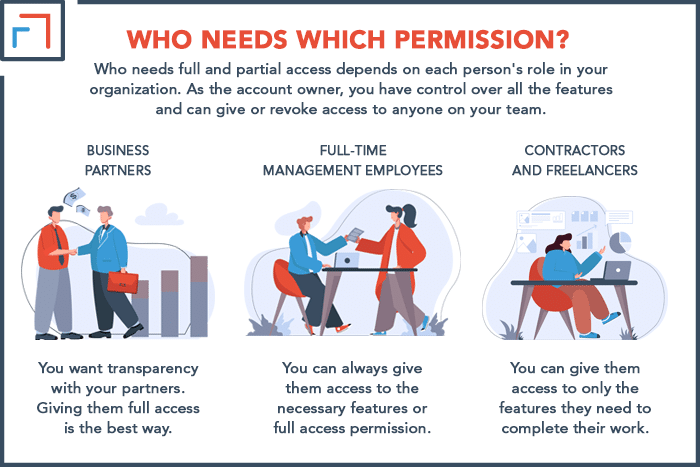
Why You May Want to Restrict ClickFunnels Access?
Businesses use ClickFunnels to build sales funnels and increase their revenue. However, as your business grows, you may want to restrict access to some features.
The main reasons businesses do this are:
1. Confidentiality
Imagine you’re working on a new product. Chances are, you’ll want to keep it under wraps until you’re ready to launch.
In this case, you may want to restrict access to the funnel feature for everyone except a few key team members.
Apart from that, sensitive information such as customer data, financials, and proprietary company information should be restricted to only a handful of people.
Most businesses have strict confidentiality agreements for their employees.
By restricting access to ClickFunnels, you can be sure that only authorized personnel will have access to sensitive information.
Some contractors may also be working with your competitors. To safeguard your business, you may want to restrict their access to only the features they need.
2. Security
Consumers are increasingly concerned about their data security, and rightfully so. Data breaches are becoming more common, and the consequences can be devastating.
By restricting access to ClickFunnels, you can minimize the risk of a data breach.
For example, if you only give your customer service team access to the contacts feature, they can’t accidentally delete important data.
We have all seen even giant companies such as Facebook and Yahoo fall victim to data breaches.
To avoid making the same mistake, you need to have a robust security strategy.
3. Avoid Privilege Misuse
Not everyone in your organization needs access to ClickFunnels. Privilege misuse is when someone with access to sensitive data uses that data for personal gain.
For example, they may sell customer information to a competitor or use it to spam people.
This could lead to broken trust between your business and customers. Sadly, the loyalty you have taken years to build could go down the drain with a few clicks.
Restricting access can also help you prevent employees from misusing their privileges at the expense of your customers.
4. Prevent Hacking
If you run a small business, you may think you’re not a target for hackers.
However, that is not the case. Hackers will target any business as long as they think they can get away with it.
You can reduce the loopholes that hackers can exploit by restricting ClickFunnels’ rights. Each user should only have access to the features they need to do their job.
Most times, hackers gain access to systems through phishing attacks. They will send an email that looks legitimate, but it’s actually a trap.
If someone clicks on the link in the email, they will be taken to a fake website, where they will be asked to enter personal details.
Hackers can then use that information to gain access to your ClickFunnels account.
5. Minimize Liability
Lawsuits have become common, and even businesses that have done nothing wrong can find themselves in hot water.
There are many ways your business can be sued, but one of the most common is data breaches.
If hackers gain access to ClickFunnels and steal customer information, you could be held liable.
You can minimize your liability by restricting ClickFunnels’ rights. By doing so, you can be sure that only authorized personnel will have access to the system.
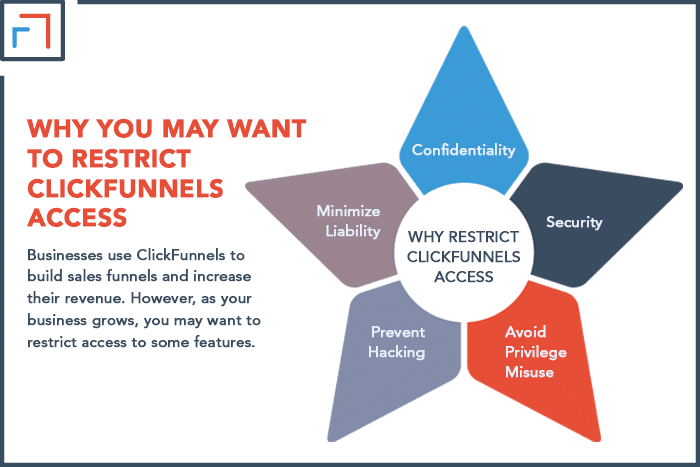
How Do I Give Access to ClickFunnels?
You can give access to ClickFunnels by adding a sub-user. To do this, you need to be an administrator on the account.
Sub-users are a useful designation. These provide a way to give people access to ClickFunnels without sharing login details.
Here is a step-by-step guide on how to add a sub-user in ClickFunnels:
1. Go to the ClickFunnels dashboard and click on your account icon in the top right-hand corner.
2. A drop-down menu will appear. Select “Accounts Setting” from the menu.
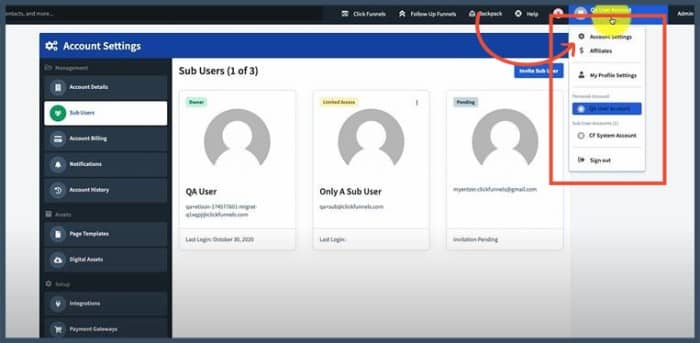
3. Select “Sub users” from the left-hand menu on the Accounts Settings page.
4. On the Sub-users page, click on the “Invite Sub User” button in the top right-hand corner of the tab.
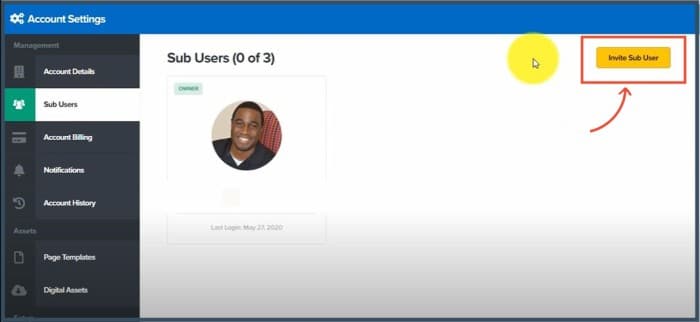
5. Enter the sub-user’s details (email address).
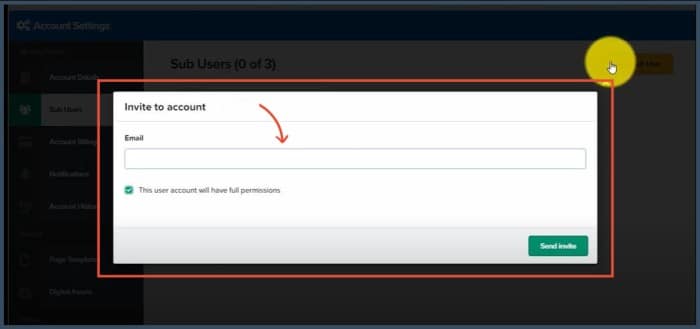
6. Below that, there is an option to select the sub-user permissions. By default, all permissions are enabled. You can disable any permissions you don’t want the sub-user to have.
7. Once you’re happy with the settings, click on the “Send Invite” button. The sub-user will receive an email with a link to create their account.
You can change the permissions or delete the sub-user by going back to the Sub-users page.
Differences between Sub-user and Membership Accounts
It’s important to note that there is a difference between sub-user accounts and membership accounts.
| Factors | Sub-User Accounts | Membership Accounts |
|---|---|---|
| Users | Workers | Clients |
| Permissions | Access to ClickFunnels | Access to your products |
| Pricing | Free | Free or paid |
1. Users
Membership accounts are meant for customers who have subscribed to your products or services.
They will have access to the membership area, and you can give them different permissions (e.g., what they can see and do).
Sub-users are people who work for your organization.
They have access to ClickFunnels’ features, but you can restrict their rights. For example, you can prevent them from deleting data or adding new users.
2. Permissions
Because sub-users are part of your team, they have access to ClickFunnels’ features. However, you can restrict their rights.
They have access to company information and can create, delete, and edit funnels and campaigns.
Membership accounts have different permissions. For example, you can create a premium course and give them access when they pay.
Alternatively, you can give them access to a free course but prevent them from downloading the course material.
3. Pricing
Sub-user accounts are free and come with your ClickFunnels subscription. On the other hand, you can charge for membership accounts.
For example, you can give them access to a course for $10/month.
The price you charge will depend on the value you’re providing. If you’re offering a high-quality course, you can charge more.
You can also give free access to membership accounts. For example, you allow account owners to get a course for free but upsell them on the premium version.
Key Takeaway
Restricting access to ClickFunnels is a great way to minimize your liability in the event of a data breach. You can give access to ClickFunnels by adding a sub-user.
To do this, you need to be an administrator on the account. ClickFunnels’ sub-user accounts are free and come with your ClickFunnels subscription.
You can change the permissions or delete the sub-user by going back to the Sub-users page.
The Basic Plan allows one sub-user, and the Platinum Plan can accommodate three sub-users.
If you’re looking for a way to give people access to ClickFunnels without sharing your login details, the sub-users option comes in handy.
